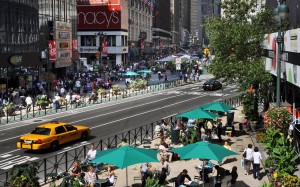A biweekly newsletter with public space news, resources, and opportunities.
A curated dispatch on all things public markets plus the latest announcements from the Market Cities Program.
New York, NY
Varied Configuration, Including Conversion of Some Travel Lanes to Pedestrian Plazas
Broadway runs diagonally through the street grid in Manhattan, creating both irregular intersections and room for world-class public spaces. Prior to this project’s changes, Broadway was congested with vehicles that were forced to idle as it converged with congested avenues. At the same time, too many pedestrians were forced onto too little sidewalk, which resulted in an unpleasant working and shopping environment, and pedestrians unsafely walking on the roadbed.
The NYC Department of Transportation (NYC DOT) determined that reconfiguring this corridor to focus on the needs of its teeming pedestrians would result in safety, livability, and mobility benefits. NYC DOT’s study predicted that removing vehicle traffic lanes, limiting turns, and closing the entire street to vehicles in places would provide much needed pedestrian infrastructure and actually reduce gridlock and improve area-wide travel times.

Beginning in 2009, New York City made changes to the design of Broadway and nearby streets, first with temporary low-cost treatments, and then with permanent designs once the benefits of the changes had been confirmed. These changes were made to roughly 2.3 miles of Broadway, from Union Square at 14th Street, north past Madison Square Park, Herald Square, and Times Square, all the way to Columbus Circle at 59th Street. In the process, NYC DOT transformed many of the most iconic and highly frequented areas in the city.
This project involved changes not just to Broadway itself, but also to nearby streets, in order to implement an area-wide transportation network overhaul that involved adjusting turning lanes, parking regulations, and signal timing. In one of the most dramatic changes to the corridor, Broadway was completely closed to vehicle traffic at Times Square and Herald Square, which created room for new pedestrian plazas and spaces, and allowed for longer signal times for vehicles at the adjacent avenues. More permanent, capital-intensive designs are forthcoming for many areas of the project. These designs will include modifications to correct issues with the original redesign.

The project was completed in two major phases. Broadway north of 23rd Street was reconfigured in 2009, while Broadway between 14th Street (Union Square) and 23rd Street was remade in 2010.
Broadway between 23rd Street and 59th Street:
Intersections simplified by closing some or all of Broadway to motorized traffic where it intersects other avenues, and creating or altering pedestrian crossing signal phases.
Broadway between 14th Street and 23rd Street:
All of Broadway
NYC DOT carefully tracked before-and-after data on the project, and found that the changes to Broadway successfully improved traffic flow and increased safety, while creating new space for pedestrians and bicyclists. The measurements collected by the agency are too exhaustive to fully explore here, but they included tracking safety by mode, traffic volumes by mode, satisfaction surveys, and area-wide trip times using on-board taxi GPS data and travel-time surveys.
Broadway between 23rd Street and 59th Street:
Broadway between 14th Street and 23rd Street:

Broadway Dreams to Be Realized: Projects for Public Spaces's efforts leading up to the transformation
NYC DOT Main Page for Broadway
NYC DOT Green Light for Midtown Flickr Photo Set (2009)
NYC DOT Photo Set PowerPoint (2009)
NYC DOT Green Light for Midtown Evaluation Report (2010)
NYC DOT Union Square Area Improvements
NYC DOT Union Square Area Evaluation
The rich text element allows you to create and format headings, paragraphs, blockquotes, images, and video all in one place instead of having to add and format them individually. Just double-click and easily create content.
The rich text element allows you to create and format headings, paragraphs, blockquotes, images, and video all in one place instead of having to add and format them individually. Just double-click and easily create content.
Body Text Body Link
The rich text element allows you to create and format headings, paragraphs, blockquotes, images, and video all in one place instead of having to add and format them individually. Just double-click and easily create content.
Here is some highlighted text from the article.




Headings, paragraphs, blockquotes, figures, images, and figure captions can all be styled after a class is added to the rich text element using the "When inside of" nested selector system.
Headings, paragraphs, blockquotes, figures, images, and figure captions can all be styled after a class is added to the rich text element using the "When inside of" nested selector system.
Headings, paragraphs, blockquotes, figures, images, and figure captions can all be styled after a class is added to the rich text element using the "When inside of" nested selector system.

We are committed to access to quality content that advances the placemaking cause—and your support makes that possible. If this article informed, inspired, or helped you, please consider making a quick donation. Every contribution helps!
Project for Public Spaces is a 501(c)(3) tax-exempt organization and your donation is tax-deductible within the guidelines of U.S. law.